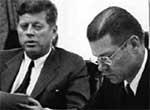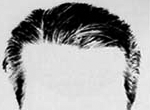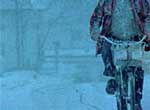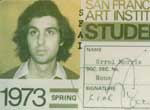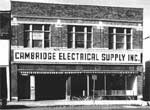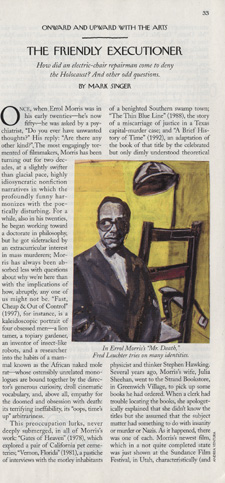 How did an electric-chair repairman come to deny the Holocaust? And other odd questions.
How did an electric-chair repairman come to deny the Holocaust? And other odd questions.by Mark Singer
The New Yorker - February 1, 1999
Once when Errol Morris was in his early twenties - he's now fifty - he was asked by a psychiatrist "Do you ever have unwanted thoughts?" His reply: "Are there any other kind?" The most engagingly tormented of filmmakers, Morris has been turning out for two decades, at a slightly swifter than glacial pace, highly idiosyncratic nonfiction narratives in which the profoundly funny harmonizes with the poetically disturbing. For a while, also in his twenties, he began working toward a doctorate in philosophy, but he got sidetracked by an extracurricular interest in mass murderers; Morris has always been absorbed less with questions about why we're here than with the implications of how, abruptly, any one of us might not be. "Fast, Cheap & Out of Control" (1997), for instance, is a kaleidoscopic portrait of four obsessed men-a lion tamer, a topiary gardener, an inventor of insect-like robots, and a researcher into the habits of a mammal known as the African naked mole rat-whose ostensibly unrelated monologues are bound together by the director's generous curiosity, droll cinematic vocabulary, and, above all, empathy for the doomed and obsession with death: its terrifying ineffability, its "oops, time's up" arbitrariness.
This preoccupation lurks deeply submerged, in all of Morris's work: "Gates of Heaven" (1978)which explored a pair of California pet cemeteries; "Vernon, Florida" (1981), a pastiche of interviews with the motley inhabitants of a benighted Southern swamp town; "The Thin Blue Line" (1988), the story of a miscarriage of justice in a Texas capital-murder case; and "A Brief History of Time" (1992), an adaptation of the book of that title by the celebrated but only dimly understood theoretical physicist and thinker Stephen Hawking. Several years ago, Morris's wife, Julia Sheehan, went to the Strand Bookstore, in Greenwich Village, to pick up some hooks he had ordered. When a clerk had trouble locating the books, she apologetically explained that she didn't know the titles but she assumed that the subject matter had something to do with insanity, or murder' or Nazis. As it happened, there was one of each. Morris's newest film, which in a not quite completed state, was List shown at the Sundance Film Festival. in Utah, characteristically (and unsurprisingly) has the working title "Mr. Death." The Mr. Death in question is Fred A. Leuchter, Jr., a geeky middle-aged fellow with a high forehead, prominent ears, a pasty complexion, thick-framed eyeglasses, and a marbly Boston accent-so quintessentially an Errol Morris character that, as the film progresses, his delivery into the filmmaker's clutches seems preordained, one more component of an eerie fate.
"I became involved in the manufacture of execution equipment because I was concerned with the deplorable condition of the hardware that's in most of the states' prisons, which generally results in torture prior to death," Leuchter declares in an opening monologue. "A number of years ago I was asked by a state to look at their electric chair. I was surprised at the condition of the equipment and I indicated to them what changes should be made to bring the equipment up to the point of doing a humane execution.
This last phrase confirms what we already know, that we've waded into the realm of chin-deep irony. Where but in an Errol Morris film-other than, perhaps, the Ravenite Social Club in its heyday-could one encounter a businesslike man cheerfully describing the proper ritual for killing another human being? Morris, a seductive cultural anthropologist, beckons, and we tag along gladly, because-well, this will surely be more fun than an Andy Hardy movie. Without giving a hint of where the film is heading, Morris allows Leuchter to expatiate upon his life and his craft. The son of a Massachusetts correctional-system employee, he started at the age of four, "as many youngsters do," accompanying his father to work, which in his case meant visiting "all of the cell areas, including the death-house area." As an adult, he designed electric chairs and lethal- injection machines, billing clients "for the parts, the labor, and the installation and a twenty percent markup, which is more than fair." Leuchter has strong views about execution protocol. Why should lethal injections be performed with the executee strapped on a gurney, staring at the ceiling? he asks, "You could put him in a contoured chair like they have in a dentist's office... at least he'd be sitting up," Leuchter proposes. "You could give him a television, you could give him music, you could put some pictures on the wall." (Here Morris cuts to a framed Currier and Ives winter scene.) As for the electric chair, he says that the optimal apparatus should regulate the flow of current evenly, so that "the meat" doesn't "come off the executee's body like the meat coming off a cooked chicken." There is also a safety issue for prison employees who must deal with the untidy aftermath of an electrocution. "I think everybody knows that urine is highly conductive." Of the four execution methods Leuchter has dealt with - electrocution, hanging, lethal injection, and gas - he himself "would much rather be electrocuted," provided that the equipment employed could be an electric chair he'd fabricated himself: "I'd like the execution procedure to go smoothly."
The interview with Leuchter illustrates Morris's methodology. It involves seating a subject in front of what Morris calls an Interrotron - a two-way mirror that is like a television screen projecting the image of Morris's face. Behind the mirror is a camera fitted with a fixed lens. Morris asks as few questions as possible, and lets the truth flow along with alternating currents of benign disingenuousness, malignant prevarication, and potentially tragic false belief. His style is to dwell on a subject-a face, in the case of an interview, or an object, and particularly a mundane one, such as a book or a drawing. There is something like a lyrical literalness in the approach: the objects, it seems, speak for themselves.
The first whiff of what's to come in "Mr. Death" is an arresting image of just that-the smoky vapor of a hydrogen-cyanide gas chamber. Leuchter is no fan of gas chambers: "Every time there's a gas execution, it's an accident waiting to happen. There is a major danger of leakage." Morris then segues to glimpses of Leuchter's personal life, including several shots of coffee brewing and being stirred in a cup. (In one scene, a reflection of Leuchter's face shimmers.) We learn that Leuchter has a forty-cup-a-day caffeine habit, and that he used to supplement it with six packs of cigarettes. While hanging out at a Dunkin' Donuts in his home town, Malden, Massachusetts, where the coffee was especially to his liking, he met his future wife, Carolyn, who worked there as a waitress. They became engaged in late l987, and shortly thereafter they went to Toronto to meet a man named Ernst Zundel. And then, at roughly the midpoint of "Mr. Death," an intertitle announces "The Trial of Ernst Zundel," and the movie jumps the divider with head-snapping suddenness. In a blink, it feels as if one had dashed to the lobby for popcorn, then dashed back into the wrong theatre, where-whoa!-a movie about Holocaust denial was being screened. Zundel, it turns out, is a notorious neo-Nazi, the author of, among other works, "The Hitler We Loved and Why," and is also the publisher of books with titles like "Did Six Million Really Die?" and "The Auschwitz Lie." And straight-talking Fred A. Leuchter, Jr., a self-described "engineer," a passionate and compelling champion even the most odious individual's right to be executed in a nice way, is about to be reintroduced to us in another of his identities-as the author of "The Leuchter Report," which is one of the most treacherous documents ever generated by the Holocaust-denial movement.
When Leuchter met Zundel, a German national who, to the chagrin of Canadian authorities, resides in Toronto, the man had already' been tried and convicted under a Canadian law that forbids the publication of a false statement that could "cause injury or mischief to a public interest." (In Germany, Holocaust denial is a crime.) But before Zundel began serving a fifteen-month prison sentence a new trial was ordered, on procedural grounds. A French associate of Zundel's attorney named Robert Faurisson, who was a leading exponent of Holocaust "revisionism" or "negationism," urged Zundel's attorney to get in touch with several United States prison officials on Zundel's behalf, seeking information about the design and operation of cyanide-gas execution devices. Faurisson wanted to prove that Zundel could not have disseminated a "false fact,"
It was Faurissson's conceit that the so-called myth of the gas chambers could be exploded by forensic analysis of the crematoria at Auschwitz and its much larger annex, Birkenau. In 1980, Faurisson had written an incendiary tract-"Memoirs in Defense Against Those Who Accused Me of Falsifying History/On the Topic of the Gas Chambers" - in which he asserted that the crematoria at Auschwitz-Birkenau were not instruments of genocide but morgues that had simply been kept very busy mainly by the high mortality from typhus and other diseases. Now he just needed a capital punishment expert to prove it. It seems, in retrospect, that at the instant the warden of the Missouri State Penitentiary referred Zundel to Leuchter - a builder of execution equipment who, by the way, has never actually witnessed an execution-an Errol Morris movie began to gestate.
In late February, 1988, Leuchter went to Poland, bankrolled by Zundel and accompanied not only by his new bride Carolyn, but also by a draftsman, a video-camera operator, and a translator. Their itinerary included a four-day inspection tour of Auschwitz-Birkenau, and, in addition, a day at Maidanek, the former concentration camp near Lublin. (Morris, who followed Leuchter's journey ten years later, briefly toyed with calling his film "Honeymoon in Auschwitz.") This under- taking was expensive-it cost thirty-seven thousand dollars-but within a few weeks Zundel reaped the yield from his investment in the form of a twenty-page document that eventually acquired near-Biblical Stature among devout negationists. The bottom line of "The Leuchter Report"-Sorry, no gas chambers at Auschwitz-rested upon the observation that that there was no ventilation of exhaust equipment or gasketed seals, or even hydrogen-cyanide residue, amid the weathered ruins of the crematoria. (I don't think the German S.S. had a death wish, "Leuchter says in "Mr. Death," paraphrasing his inductive reasoning.) In Leuchter's jargon, the assembly line for the crime of the century is referred to only as "the alleged German execution gas chambers."
"The Leuchter Report" avers of Krema I at Auschwitz, "It would be sheer suicide to attempt to utilize this morgue as an execution gas chamber. The results would be an explosion or leaks gassing the entire camp." At a number of sites within Birkenau-most notably the imploded, cavelike interior of Krema II and a building where Zyklon B, which was a trade name for the most convenient source of hydrogen cyanide, had been used to delouse Inmates clothing-Leuchter did something utterly appalling. Auschwitz-Birkenan is now a museum, and every day pilgrims to the crematoria recite memorial prayers and leave behind lighted candles and tiny wooden tablets inscribed with the names of Holocaust victims. This did not deter Leuchter from hacking away wherever he pleased with his hammer and a chisel. The video camera recorded his labors. Sometimes wearing a surgical mask and sometimes not, he gouged a wall here and a ceiling there, sealed the dislodged fragments in plastic bags, and offered a simultaneous narration that sounded like a parody of the old "Mr. Wizard" kids'-television program. When it came time to leave the country, he wrapped these souvenirs in his dirty laundry and concealed them in his luggage.
Back home, Leuchter delivered his plunder to a laboratory in Ashland, Massachusetts, and there a chemist named Jim Roth, unaware of the origin of the material, performed an analysis that found a significant level of cyanide in fragments removed from the delousing building but negligible or no traces in the specimens from the cremato- ria-proof, according to Leuchter's logic, that the mourners at Auschwitz have come to the wrong place. The most concise explanation to counter Leuchter's conclusion is that a much higher concentration of Zyklon B is required to kill lice than to kill human beings, and that the delousing building had remained intact while the crematoria, which were dismantled and dismantled by the Germans (or, in one case, by insurrectionist inmates) before the camp was liberated by the Allied forces, had been exposed to the elements for forty-three years before Leuchter came along. Nevertheless, Leuchter did much to reinforce a maxim favored by negationists: "Only lice were gassed in Auschwitz"-a slur that echoed, not coincidentally, Hitler's characterization of Jews as a plague of vermin.
Morris first became aware of Leuchter in 1990, when he was featured in a front-page Times story headlined "MAKING EXECUTION HUMANE (OR CAN IT BE?)." Only in passing, and well down in the article, did the Time's mention Leuchter's role in the Zundel case. Though Morris immediately recognized Leuchter as a potential subject, he was occupied with other projects, and a year and a half elapsed before it occurred to him that Leuchter was living in Malden, not far from his own home, in Cambridge. He sent an assistant to a revisionist-affiliated gathering with instructions to introduce himself to Leuchter but not to ask many questions. The assistant wound up tape-recording an interview during which he couldn't get Leuchter to shut up-a phenomenon that Morris soon experienced at first hand, upon placing him in front of a camera.
The Leuchter saga seemed to offer Morris the chance to fulfill a long-nurtured ambition, "to make a Holocaust movie without reference to what other people have done." Morris thought about adding Leuchter to the menagerie of monomaniacs he'd gathered for "Fast, Cheap & Out of Control," a notion he abandoned when his wife advised, "Properly considered, Hitler is not a Spice." I once asked Morris his opinion of "Schindler's List," and he said, "Spielberg has the interesting thesis that anybody can be a hero, whereas I have the far more interesting thesis that anybody can think he's a hero." It's an important Morris principle: we never truly know what we presume we know. Not until a year ago did Morris finally have the funds, thanks to the Independent Film Channel and Britain's Channel 4, to create the movie he had in mind, and by then he was far from certain how to make sense of his subject. The Leuchter he had trotted out in an early fundraising prospectus was a decidedly sinister figure-"an insidious force that must be examined closely so that his views can be challenged and, ultimately, he can be deterred." By the time Morris had secured the money, though, he realized that he had options more daring than representing his protagonist as evil. The story would be far more interesting if it plumbed the underlying mystery of Leuchter's identity and motivation. Had Zundel set him up? Was he a patsy? In any event, was there a risk that by giving a denier of the Holocaust a platform Morris would end up legitimizing him? In the end, Morris elected to let Leuchter and other witnesses tell the story of "The Leuchter Report" in their own words: how it derailed Leuchter's life, how it became its author's tar baby-a piece of personal history from which he could never escape.
At Zundel's 1988 trial, Leuchter was allowed to appear as an expert on contemporary gas-chamber design, and the findings from his Auschwitz journey, "The Leuchter Report," were submitted to the court on Hitler's birthday a copy of the report was accepted as an informational exhibit, but not as evidence. After Leuchter took the stand, the judge stipulated that the Holocaust had in fact occurred. Zundel was again found guilty; on balance, Leuchter's testimony hadn't much mattered. What did matter was that "The Leuchter Report" survived beyond the trial. Indeed, today it can be downloaded from a Web site maintained by Zundel. For a couple of years after the report's publication, Leuchter himself didn't seem to be doing badly. His execution- equipment business continued. He rebuilt Tennessee's electric chair and was retained as a consultant by the State of Florida after a bungled electrocution caused a condemned man's head to catch fire. And by now he had a legion of grateful admirers, whom he perhaps thought of as friends-members of the Holocaust-denial mob. Zundel, tantalized by the possibility of a series of sequels to "The Leuchter Report," sent him in 1989 on a tour of Dachan and other sites in Germany and Austria, during which he was joined by Faurisson and other prominent negationists. He was embraced by the loathsome British historian David Irving-described by Ron Rosenbaum, in his book "Explaining Hitler," as the Fuhrer's "chief postwar defender"-who extolled the "gruesomely expert author" of "The Leuchter Report" and labeled its results "shattering" and "truly astounding."
Unavoidably, Leuchter became a target of Jewish activists, and it was only a matter of time before prison wardens stopped hiring him. In Massachusetts, he was prosecuted and threatened with jail for practicing engineering without a license. In 1992, he went to Germany, again to testify on Zundel's behalf (Zundel had been charged with violating Germany's Holocaust-denial staturee after organizing an International Leuchter -Kongress in Munich); while there, he, too, made what the authorities deemed a Holocaust-denial speech. The next year, Leuchter was again lured to Germany, ostensibly to appear on television to talk about electrocution, but he was arrested the day he arrived and charged with "slander of the murdered Jews." He spent six and a half weeks in prison before he was finally bailed out by Zundel, and a trial was scheduled for 1994. He has never returned to Germany. Also, in 1994 his marriage came unraveled, whereupon he moved to California and, for a long while, as far as Morris was concerned, simply vanished.
One day last winter, I got a call from Morris, whom I'd written about previously, and for more than an hour, beginning at the beginning, he recited the tale of Leuchter thus far. No less compelling, I immediately felt, was the story of the story-Morris's pursuit of Leuchter, whom he'd tracked down by now with the help of a private detective, and his struggle with the implications of how his work- in-progress would portray its central figure. But how complicated could Leuchter be? Wasn't he a simple sower of foul deeds, a perpetrator of calculated cruelty? Morris perceived, instead, a "truly enigmatic character." Conspicuous Holocaust deniers occasionally get their homes or offices fire bombed or they get beaten up or, more often, they get sued or prosecuted; the potential for martyrdom clearly lends an allure to the enterprise. In the film, Leuchter comes across by turns as an accidental and defiant martyr, a banal but strange man launched on an inexorable, often hilariously grotesque, journey-a legend, as the saying goes, in his own mind.
Morris described to me the screening of an early rough cut at Harvard, which had left him shaken. "It seemed that that audience had no place to stand outside Fred," he said. "They became trapped in his ego. They took him quite literally. And when the film was over there were people in the room who wondered whether the Holocaust had really happened."
I asked Morris what he now thought about his subject. "On different days, I feel different things," he said. "Fred's story raises lots of interesting questions, such as: What happens if you really need to be loved and the only people who will love you are Nazis? And his version of what he saw in Auschwitz and what happened to him afterward seems to come right out of Nabokov-- the clueless narrator, the narrator so far out of touch with what he's saying that it's totally absurd. But how clueless could he possibly be? That's the central mystery. Do we all have these self-invented fables? There's a deep mystery about why Fred's doing what he's doing, and for me it connects with the mystery of the Holocaust the mystery not of whether it happened but of how it could happen. Is it happenstance that Fred, a person obsessed with death-not unlike me-ended up at Auschwitz? Somehow, he was drawn there, pulled to the center of twentieth-century death. And maybe it's pulling me, too. It's one of my predilections that people do not do evil knowingly. Evil is always construed as some form of doing good. We are always in some kind of delusional state about what our actions mean. I hope this movie becomes more effective if Fred emerges as more a person like you and me. If it's a movie that creates one more Manichaean illustration of good and evil, it becomes less interesting. If he becomes a person who makes us think about how the Holocaust came about, then it's useful."
Six weeks later, in early April, I flew to Warsaw and then to Krakow, was driven an hour or so to the small Polish city of Tychy, and checked into the hotel where Morris and his film crew were staying. Later that afternoon, I proceeded to Birkenau, three kilometres from the original camp-Auschwitz I, on the outskirts of the village that after the war reclaimed its Polish name, Oswiecim. The content of the film hadn't progressed beyond the rough cut that had been screened at Harvard, but, if all went well, by the time Morris left Poland he would have filled many of its most perilous gaps. These gaps, I recognized when I viewed the rough cut at the hotel, existed as a function of Leuchter's dorky charm. He possessed an unsettling, earnest forthrightness-the capacity to trigger cognitive dissonance. A lot of what Leuchter had to say was dangerously off-the-wall, and Morris was well on his way toward creating yet another compulsively watchable movie.
Since arriving, three days earlier, Morris had spent his time scouting locations. He was trying to acquire a ground-level sense of a vast place he'd previously been familiar with mainly through the images of Leuchter's ten-year-old videotape; he wanted to film scenes, using actors, that would reenact that bizarre home movie. In other words, he would repeat what he first did with great success in "The Thin Blue Line"-create stylized dramatic reproductions of real-life events. In the final film, these scenes would be juxtaposed with the Leuchter videotape, which Morris had once described to me as "the most surreal piece of film I've ever seen. and he had added, "Move over, Mr. Bunuel. Nice try, but you have competition." Morris's schedule called for two full weeks of shooting. He planned to photograph blueprints and other documents in the Auschwitz museum archives-to introduce explicit references to the existence of the gas chambers (and to the inadequacy of Leuchter's argument). And he would Interview a Dutch-born historian, Robert Jan van Pelt, an authority on the camp's genealogy and evolution into a death factory and the co-author of a hook entitled Auschwitz: 1270 to the Present," published in 1996. That first afternoon, van Pelt and I walked along a path parallel to railroad tracks that entered the main gate of Birkenau and terminated half a mile later. On our right was a perimeter of barbed wire, and, beyond that, twenty wooden barracks, which gave way to an endless gridwork of brick chimneys-a ghostscape that remained wherever the barracks had come down. On our left was another border of barbed wire, then brick barracks, and, In the distance, the Carpathian Mountains. At last, we reached a crossroads, the spot at which trains dispatched from all over Europe by Adolf Eichmann had been halted and new arrivals were lined up--mothers, children, and the elderly here, able-bodied men and women there. This was where the infamous "selections" had taken place, where the S.S. literally expropriated the divine prerogative: deciding who shall live and who shall die. From this nexus, at the height of the gassings, in 1943 and 1944, the doomed would be consigned to the crematoria and, typically, would be dead within a couple of hours.
"If I had to create a geography of evil, this would certainly be my center point," van Pelt said. "Many people consider this the most important place in their life. I'm not a Catholic, but I wouldn't go into a Catholic Church and piss on the altar. There are standards of human decency. Fred Leuchter came here for two or three days and took samples. I don't want to deny people the right to doubt. But I want them to do it after they've done their homework; I hate Holocaust deniers not just for their moral atrociousness but because they're sloppy craftsmen. I walk around here and I still find things that I don't understand-why they're here. This is an enormous place. This is a city. Originally, there were a hundred and twenty-five architects and draftsmen working here. Why would one or two people think they can come here and in two or three days understand this place?"
The next morning, Morris shot footage inside one of the three remaining delousing buildings, including a disquisition by van Pelt, who posed in front of what he sardonically called "the Wailing Wall of Holocaust deniers"-the spot from which Leuchter had chiseled material that turned out to possess a relatively high cyanide content; this became the control against which other samples from the "alleged gas chambers" were measured. Walking through the delousing building in midmorning, I inadvertently interrupted a scene from Morris's reenactment of the Leuchter videotape. Either as punishment or as reward, Morris decided that I was photogenic enough to be cast as Leuchter's video cameraman. "Remember," he told me as I was being outfitted with a parka and a prop camera, "you'll never again get to be in a Holocaust-denial film." One of the producers, David Collins, who had assumed the role of Leuchter, wore a Russian-style hat with earflaps and a sheepherder's coat of cocoa-brown leather with fake fleece. Verisimilitude was possible because Leuchter had worn this very garment ten years earlier and had lent it to the filmmakers-an impenetrable gesture of complicity. (How could Leuchter grasp what Morris was actually up to?)
Later that day, after touring the crematoria, I wound up a couple of hours before sunset at Krema II. Powerful klieg lights were perched on the collapsed roof of what had been an underground gas chamber, next to an opening slightly larger than a manhole. Morris, his cinematographer, and David Collins-as-Leuchter had descended through this doorway to hell, just as Leuchter himself had done ten years before. While they worked, the rest of us, at ground level, distracted ourselves with mildly nervous kibbitzing. Or else we wandered about on our own, discovering in the passages of silence the sneaky way that the imagination will try to wrap itself around the unimaginable. In the near distance, beyond the birches along the Birkenau perimeter; I could hear roosters crowing, dogs barking, a chainsaw, and the sounds of children playing in the back yards of farmhouses that had been built after the war with bricks salvaged from the crematoria.
At dinner that night, back at the hotel, Morris and I talked about his reenactments from the Leuchter videotape. "Because Fred uses a handheld camera and shoots with available light, his film is somehow authentic, verite-in-a-nutshell, 'true' cinema," Morris said. "The irony here is that his cinema verite is in the service of falsehood. And my contrived material, I like to think, is in the service of the under- lying truth"-a two-beat pause-"but, of course, I could be wrong."
And what was one to make of David Collins, who, as the Leuchter doppelganger, wore a surgical mask? On camera, Leuchter had explained that he wore a mask so as not to contaminate his specimens. "On the videotape, he actually neglected to wear the mask ninety per cent of the time," Morris observed. "I guess what you're saying is that Holocaust denial isn't an exact science," I proposed. "Yes, you're right," Morris said. "It isn't a science at all. It's an art."
After returning from Auschwitz to Cambridge, Morris had a sinking spell. In recent years, he has supported his filmmaking by directing television commercials, and now, studying the footage of Auschwitz, he began to worry that it looked like "product." As the summer and the editing progressed, however, he grew more sanguine. He interviewed Leuchter again- their first meeting since 1992. It was a twelve-hour session, at the end of which Leuchter gave the impression that he could have talked for twelve more. "I always thought I could outlast any person I've been interviewing," Morris told me. "But I've met my match."
In September, he invited me to watch a day of shooting, which began in an apartment building in Revere, a suburb north of Boston. Leuchter was present, bantering with the crew, preparing to reenact scenes from his own life. I asked Morris, Does Fred know yet what this film is about?"
"I don't know yet what this film is about," he replied.
The first scene that day-one that wouldn't survive the cutting room-depicted Leuchter's experience in 1994, when he was evicted from a hotel that had been his home in Los Angeles. While another shot was being set up, he relaxed in the living room of an apartment that had been rented as a location. He wore a short-sleeved yellow dresshirt, a brown necktie, cuffless beige chinos, beige socks, and white loafers. Gulping away at his daily coffee quota, he worked around to one of his favorite topics: botched executions. From a riff about a Florida convict who had to be physically subdued before he could be brought to the electric chair, he shifted to Louisiana: "I was looking at the autopsy photos and I could see damage to the heads of the executees. They were screwing self-tipping screws directly into in person's skull to get a good contact for the electrodes, and they did this while the executee was conscious.
"Isn't Fred a sweetie?" Morris said to me after Leuchter had moved into the bedroom for the next scene. It was a peculiar rhetorical question, undoubtedly sincere and yet-what? Morris was making a film that would have what effect upon Leuchter's life? Could the film possibly enhance it? And Leuchter had presumably agreed to cooperate because he was being treated like a very important person. Morris seemed to hang on his every word, was recounting the narrative of his undoing, for the purpose of-again, what? At one point, Leuchter said to me, "Every time I stick my head up, I get shot at." The world was a hostile, dangerous place-he'd genuinely feared for his life while imprisoned in Germany-yet he seemed remarkably guileless. (Hence; Isn't Fred a sweetie?) On another day's shooting, between takes, Morris said. "Fred hasn't questioned anything we've asked him to do over the last five days. I haven't lied about anything. I haven't had to; he's too honest and decent a man, I look over all this, and I think he's just misguided. He got mixed up with the wrong group of people. There are people who think he's evil, but he's not. The movie, I think, is becoming a kind of odd danse macabre, with Leuchter as my brand of existential hero, or, if you like, existential antihero-the completely benighted human being who still deserves our sympathy." The filming that day lasted twelve hours-until three-thirty in the morning, by which time everyone on the set except Morris and Leuchter was desperate to go home. Leuchter never flagged. Not only was he an actor but Morris had turned him into a major- minor movie star. "Cinema verite!" Morris exulted after one successful take. "The camera loves Fred!"
Perhaps so, I thought at that moment. Something or someone surely must love Fred Leuchter, though neither love nor any form of penitence I could imagine would erase the stain of his most noteworthy achievement- careering from one mass-murder site to another with a busted moral compass, along the way bringing joy to truly depraved people who were determined to obliterate the most basic truths about the crimes of the Third Reich.
During the making of "Mr. Death," Morris augmented his usual complement of anxieties with a sense of dread at what might happen when he showed Leuchter the completed film. In addition to van Pelt, Morris had enlisted Jim Roth-the chemist who had analyzed Leuchter's forensic evidence- as a rebuttal witness. Only after he testified at Zundel's trial, Roth told Morris, did he realize where the material he analyzed had originated. He acknowledged the limitation of his analysis: cyanide, by its molecular nature, would have bonded with the iron in the brick of the gas chambers only on the surface-ten microns deep, just one-tenth the diameter of a human hair. Thus, when a chunk of brick was crushed in the lab, the material beneath the surface would have diluted the specimen, rendering the test pointless. Looking into Morris's camera, Roth summarized, "I don't think the Leuchter results have any meaning.
Finally, on the morning of New Years Eve, Morris and Michael Williams, one of his producers, invited Leuchter to a very private screening of the version of the movie that would be shown at the Sundance Film Festival. "The reason to show it to him was, on a very simple level, so he wouldn't feel blindsided when the film is released," Morris said. During the eighty-three minutes the film was running, Leuchter was atypically silent. Afterward, he announced that he liked it very much, though he objected to statements made by van Pelt and Roth.
At one point, Leuchter reversed roles and asked Morris, "What is the film about to you?"
"It's a good question," Morris said, laughing. "What it is about is my curiosity-how you got yourself into this fix."
This sounded like a euphemistic version of an essential tenet in the Morris epistemology-"the fundamental Cartesian error: the notion that people have privileged access to their own minds." It didn't bother him in the least that seeing the movie hadn't altered any of Leuchter's basic opinions. "Nor did I want to try to convince him that the Holocaust happened," Morris told me later. "Say I did get him to admit that poison gas was used, that there were gas chambers at Auschwitz-so what? Would that make me any different from Zundel. Would he be saying all this because he wanted to please me? Would I have become a new friend, a new interest group-instead of the neo-Nazi group, the filmmaker-group-making-a-film-about-a-neo-Nazi group? All along, I viewed Leuchter as such a tangled mixture, There's not just one person there, There's Fred as self-invented American, Fred as entrepreneur, Fred as Sherlock Holmes, looking for the telltale trace that reveals the meaning of the world. He's the Florence Nightingale of death row. When he testifies for Zundel, he's the champion of free speech, the civil libertarian, the humanist, humanitarian, seeker of truth, martyr. By the end, there's Fred as fall guy, Fred as victim of the Jews. When he talks about how at Auschwitz he was afraid of the guards, how he had an escape plan in case he got caught-it's as if he were talking about himself as a Jew in 1943 or 1944, rather than as a Holocaust denier vandalizing the site. So, in the end, I'm left with the question 'Do I know who Fred is?' Plus one other question, which I assume will stay with me for a while: 'Do I know who I am myself?"


